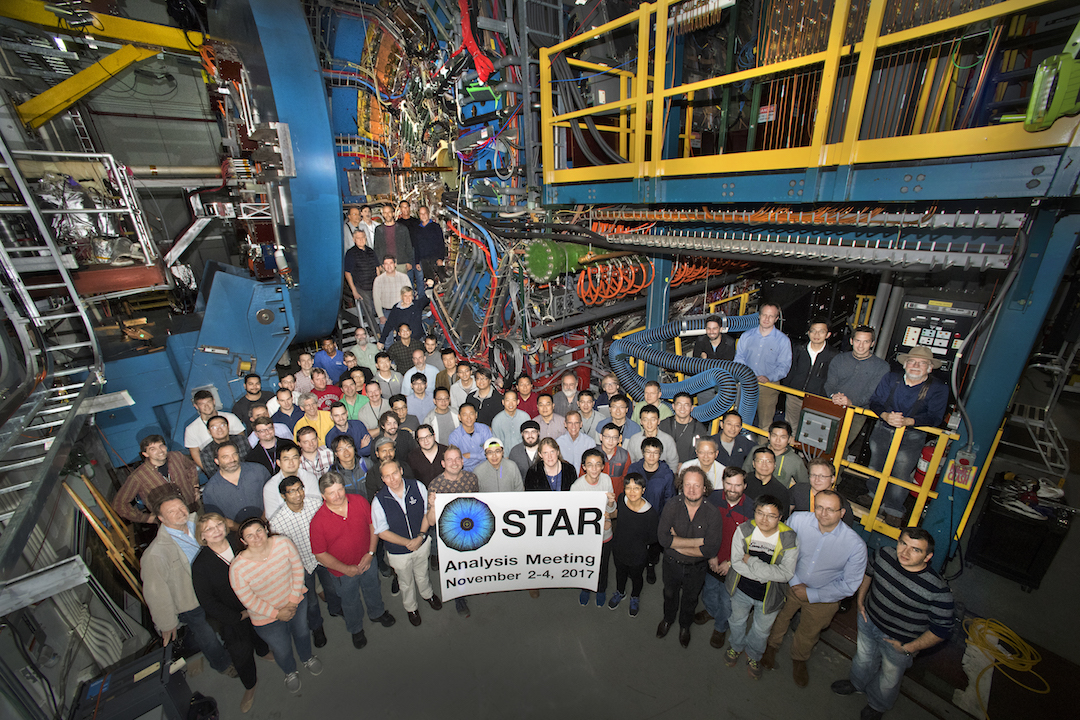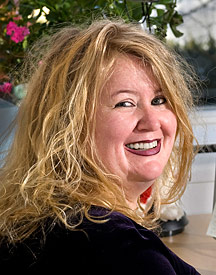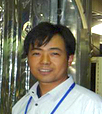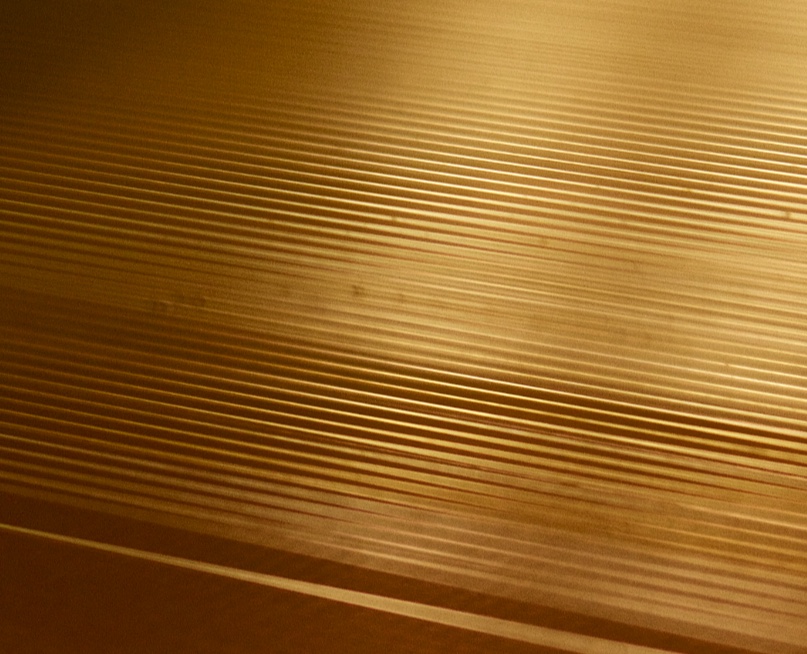December 2017
STAR Newsletter
December 2017 edition
Contents:
- In Memoriam: Prof. Hongfang Chen
- From the Spokespersons
- STAR Analysis Meeting Recap
- Collaboration Members in the Headlines
- STAR Holiday Gathering
- STAR arts
A note from the editor: as a collaboration-wide communication tool, this newsletter is set up to allow comments (subject to moderation against abuse), and all STAR Collaborators are welcome to do so! Please keep in mind that some content (including all comments) may be considered internal to the Collaboration and only accessible when logged into Drupal. Documentation is available here.

Prof. Hongfang Chen examines the iTPC sector hardware along with other members of the review one year ago.
(Zhangbu Xu - Co-Spokesperson)
Dear STAR Collaborators:
It is with a heavy heart that I share with you the sad news of the passing of our beloved collaborator, Prof. Hongfang Chen from University of Science and Technology of China, at the age of 80 on December 14th, 2017.
Prof. Chen had been the leader on R&D and production of the state-of-the-art Multi-gap Resistive Plate Chamber (MRPC) for the STAR Time-of-Flight (TOF) project through the 2000’s. She carried out the assembly of the prototype at USTC and the beam test at the AGS herself. As the principal investigator for the STAR TOF R&D and production, she guided us through trying times and led the project to success. This extraordinary and exemplary success has led to a few subsequent collaborative US-China projects for STAR: the Muon Telescope Detector (MTD), High-Level Trigger (HLT), inner Time Projection Chamber (iTPC), Event-Plane Detector (EPD) and endcap TOF. There is no doubt that we owe her an enormous debt of gratitude for a versatile and rich scientific program, enabled by the addition of all these detectors to STAR. When I invited her to be on the committee to review iTPC production readiness at Shandong University in December 2016, she went over the production procedure and review wholeheartedly. The photo of her examining the iTPC sector is a lasting memory and example of her hands-on and dedicated attitude towards scientific research.
She has continued to guide and advise us through those projects in the last decade, but has voluntarily yielded recognition and leadership to younger generations. It is on the shoulders of Prof. Chen and scientists like her that many of us enjoy scientific research in the collaboration. She has not only been well known for her scientific accomplishments, but also for her nurturing of generations of scientists over more than half a century as an outstanding and diligent educator. USTC has become one of the most productive institutions, with 18 PhD graduates and many principal-author publications in STAR. Seventeen of these graduates continue in the field. Her influence has been very far-reaching. The alumni from her program and her teaching have had an enormous impact, way before and beyond STAR. Just as an example, 25 years ago, as an undergraduate in her group, I was trained to set up a cosmic-ray test stand for BaF2 crystals and to measure scintillating light decay time with single photons. Scientists like her inspire us to follow in their footsteps and to continue a career along their path.
Her life is inspiring as well. The touching legend on the USTC campus says that every day except Sunday, a couple of senior professors would walk from the apartment area at one corner of the campus to the science buildings at another corner of the campus at exactly 8:10 AM. Prof. Chen and her husband, Prof. Wang, both distinguished professors at the Department of Modern Physics, chose to stay on the main campus while many other faculty members live off-campus amid the real estate boom of the last decades. They did not talk too much along the way but were in sync of the slow and steady steps. They smiled and nod to people who greet them along the way. It was a simple and elegant lifestyle many envy but difficult to maintain. In the last 15 years, I have frequently visited USTC. There was always a spot in her small office where I could sit and work during my visit. We would discuss about TOF/MTD detector design and performance, and related scientific projects. She would tell me the strength and weakness in her former students and colleague and how important it is to promote the young scientists. In the last days of her life, battling Pulmonary Fibrosis lung disease, I visited her at her apartment on campus in September, while en route to the CBM-STAR meeting in Wuhan, just like many of her former students who visited her at home and in hospital. She was in very good spirits and discussed with us about the STAR program and the young scientists in the group. Her husband would tell us about their daily life through more than half a century, and what life and love mean as one grows older by the decade, a concise living example of what was written in “Confucian Analects”.
The legacy of Prof. Chen’s kind spirit, passion for science, nurturing of the next generations, and her humble and elegant lifestyle will live on through all of us who have known her and have been touched by her life.
A blog has been set up for friends to leave their condolences, and as a celebration of her life. You can also send email to Prof. Ming Shao (swing@ustc.edu.cn) and he will help you post your note. You are also welcome to add your own memories and/or thoughts as comments to this edition of the STAR Newsletter.
Sincerely,
Zhangbu Xu

(Helen Caines & Zhangbu Xu - Co-Spokespersons)
Happy Holidays to everyone; we have much to celebrate as a collaboration!
As 2017 comes to a close I want to thank everyone for helping make our 17th year of operations as scientifically rich and successful as we have ever been. Congratulations again to Elke Aschenauer (see below), Yu-Gang Ma (also see below), and Ernst Sichtermann for the national recognition they each received for their important contributions to the field. We also celebrated the successful completion of 21 Ph.Ds. and Prashanth Shanmuganathan and Zilong Chang winning the RHIC/AGS thesis award. This year 3 new institutes joined the collaboration, members gave more than 120 presentations (including several by undergraduates at our national conferences), and we published 12 peer reviewed articles, with another 9 papers submitted and awaiting referee reports. Our first paper using HFT data was published with several more from the HFT and MTD in the pipeline, while our Nature article on the first observation of Lambda polarization captured the public’s imagination culminating in Discover magazine naming it one of the top 100 discoveries of 2017.
The high-quality data collected in Run 17 should allow a precise measurement of the Sivers function as well as shedding light on several aspects of transverse momentum dependent distributions. Experimental verification of the predicted sign-change of the Sivers function tests fundamental aspects of QCD and is a DoE NP performance milestone.
As reported in a November press release, our S&C group are now using the CORI supercomputer at NERSC to reconstruct our data - this is the first time this has been done by a nuclear physics experiment— which could dramatically reduce the time it takes to make data available for analysis.
Looking to the future, over at the ring the STAR hall is humming with people preparing for our 2018 isobar run. The BES-II upgrades are proceeding well. The EPD is on schedule for full installation prior to Run 18, the first sector of the iTPC has been installed, and eTOF commissioning will continue this year. Our proposal to BNL to significantly enhance of forward capabilities was very well received by the PAC. They acknowledged the compelling physics case for forward upgrades at RHIC and the importance of the proposed measurements for informing the future EIC program. Finally, in November we received a statement of support from the Berndt Müller, BNL ALD, reconfirming the Lab's strong support for STAR continuing to pursue a compelling program of groundbreaking science beyond the BES-II.
We look forward to another exciting and productive year, and to seeing you all at the Collaboration Meeting at LBNL in January.
Helen and Zhangbu
STAR Analysis Meeting Recap
(Zhenyu Ye - Physics Analysis Coordinator)
We had an Analysis Meeting on November 2nd-4th, 2017 at Brookhaven National Laboratory. The meeting was focused on physics data analyses, with about two days of parallel sessions within each PWG, as well as across PWGs for Event Plane Detector, Heavy Flavor Tracker (HFT), Forward Meson Spectrometer (FMS), blind data analysis, and isobar data running for Chiral Magnetic Effect (CME) measurements. The plenary sessions had presentations on various software topics by Jérôme Lauret, Dmitri Smirnov, Irakli Chakaberia, Aihong Tang, and Grigory Nigmatkulov, Spin and Cold QCD theory by the invited speaker Yuri Kovchegov from the Ohio State University, STAR Spin and Cold QCD program by Carl Gagliardi, Analysis Binding Committee by Jim Drachenberg, CME studies by Jiangyong Jia, HFT data analyses and EPD status by Xin Dong and Mike Lisa, respectively. The meeting concluded with PWG reports of data analysis statuses and Quark Matter 2018 plans.
Thanks,
Zhenyu

Photograph by Roger Stoutenburgh, BNL Photography
Find yourself in the photo: click on the image to see a high resolution version.
Collaboration Members in the Headlines
Congratulations go out to the following STAR Collaboration Members:
- Elke Aschenauer
-
Humboldt Research Award:

"The award is granted in recognition of a researcher's entire achievements to date to academics whose fundamental discoveries, new theories, or insights have had a significant impact on their own discipline and who are expected to continue producing cutting-edge achievements in the future." Elke was selected for this prestigious German national award in October 2017. - David Kapukchyan
-
Best Oral Presentation at the BNL Early Career Researcher Symposium:

David is a University of California Riverside graduate student working with the STAR Cold QCD group on the post-shower construction, operations, and first analysis. See photos from the event here, and the corresponding BNL News article about the event and awards here (available on the internal BNL network only). Also, David's talk is available here. - Yu-Gang Ma
-
Elected to Chinese Academy of Sciences:

"As the highest national academic title in science and technology, CAS membership is a lifelong honor. However, members also have a responsibility to model academic integrity and advance their fields. The Academic Divisions of CAS play an important role as the top think tank involved in China’s economic and social development. The Academic Divisions produce dozens of consulting reports and suggestions on key issues every year, supporting state decision-making on economic and social development, national security and progress in science and technology."
STAR Holiday Gathering
(Gene Van Buren - BNL)
STAR Collaborators who were at BNL this month gathered to celebrate the holidays together on December 13th. Approximately 50 people attended, including some family members, to enjoy good food and great company. A few STAR T-shirts were seen, but alas no pie chart sweaters this year. Many thanks to Rachel Nieves and Liz Mogavero for organizing!
STAR arts
(Gene Van Buren - BNL)
This is a recently introduced feature we're trying with the STAR Newsletter for Collaborators to contribute something creative/artistic that relates to STAR. This could be a really cool looking graph generated from some analysis, or a striking photograph. The idea is akin to the "Back Scatter" feature of Physics Today (example), or the Picture of the Month of CERN Courier (example). Please feel free to have fun with this and consider making a contribution yourself for the next edition!

Close-up photo of the old TPC inner sector 20 wire planes taken when the new iTPC sector was inserted this fall
Previous Edition: October 2017
Groups:
- Printer-friendly version
- Login or register to post comments

